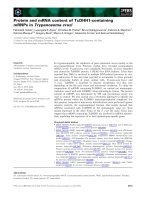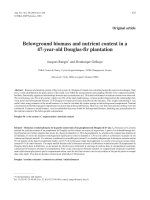Lecture7 semanticsSENTENCE MEANING AND PROPOSITIONAL CONTENT
Bạn đang xem bản rút gọn của tài liệu. Xem và tải ngay bản đầy đủ của tài liệu tại đây (807.24 KB, 44 trang )
CHAPTER 7
SENTENCE MEANING AND
PROPOSITIONAL CONTENT
1
CHAPTER OUTLINE
1.1 Proposition
1.2 Propositional content
1.3 Notational representation of propositions
1.4 Truth functionality
1.5 Sentence types and their meaning
2
1.1 Proposition (Revisited)
• A Proposition is defined as the invariant meaning expressed by a sentence, devoid of
any modality.
e.g.
She is probably right.
• Proposition: She is right
• Modality: varying from probable to impossible
• In semantics, the letters ‘p, q, r’ are often used as symbols of propositions.
• Propositions involve in the meanings of not only declarative, but also interrogative and
imperative sentences.
e.g. Is she right?
(You) be careful
3
Truth-value vs. Truth-conditions
• The truth value of a proposition should be distinguished from
the truth conditions of a sentence
e.g.
Mary married a rich man.
• Truth value of a proposition: The proposition can be either
true or false (hence a two-valued proposition).
• Truth conditions of the sentence:
Mary must be a woman.
Mary is of a marriageable age.
4
1.2 Propositional content
1. Propositional content
2. Semantic roles
3. Predicates & Arguments
5
Propositional content
• A proposition usually consists of (a) something which is named or talked about known as
ARGUMENT (tham tố/tham thể) or entity, and (b) an assertion or predication made
about the arguments expressed by the PREDICATE (vị từ).
e.g.
The man bit the dog.
The dog bit the man.
• Predicate: BITE
• Two arguments: MAN & DOG
• The meaning of a sentence consists of the predicate, argument(s), and the role of each
argument. When we specify all these elements, we are talking about the propositional
content of the sentence.
6
Arguments
• Not all entities are arguments.
e.g. It rained heavily.
• The arguments may fall into two sub-groups: participant and non-participant.
• Participants are those necessitated by the predication, and answer the question: Who
does what to whom?
• Non-participants are optional and answer the questions: why, when, where, how?
e.g. The woman hit the man (with a ruler)
• There are three arguments: the woman, the man, ruler
• In standard grammatical treatment, participant arguments surface as subject, direct or
indirect object whereas non-participant arguments occur as adverbials.
7
Predicator - Predicate
• A PREDICATE is any word, or sequence of words, which, in a given single sense, can
function as the predicator of a sentence.
e.g. hungry, in, asleep, hit, show, bottle: are predicates
and, or, but, not: are not predicates
• Predicate (vị từ / vị thể) and predicator (vị tố) are terms of quite different sorts. The term
‘predicate’ identifies elements in the language system, independently of particular
example sentences.
• The term ‘predicator’ identifies the semantic role played by a particular word (or groups
of words) in a particular sentence.
• A simple sentence has one predicator, although it may well contain more than one
instance of a predicate.
/>
8
Degrees of predicates
• The combination of predicate and arguments can be defined in terms of degree. The
DEGREE of a predicate is a number indicating the number of arguments it is normally
understood to have in a simple sentence.
• A predicate of degree one (often called a one-place predicate) is used with one argument.
e.g. asleep, beautiful
• A prediate of degree two (often called a two-place predicate) is used with two arguments.
e.g. kill, see
• A predicate of degree three (often called a three-place predicate) is used with three
arguments.
e.g. give, make
9
Arguments vs. predicates
• Arguments refer to entities while predicates deal with events, properties,
attributes and states.
• Those individuals that are independent and can stand alone are arguments.
• Things like qualities, relations, actions and processes that are dependent and
cannot stand alone are termed predicates.
e.g.
my computer
break down, fast, new
10
Predication
• The relationship between entities as arguments and events, qualities, states as predicates is
predication.
• Frawley (1992) defines predication as the way that individuals instantiate – embody, carry
out, take on or are linked to – properties, actions, events, attributes or states.
e.g. My wife is writing a report.
• The event is “writing” because “writing” must be done by someone, an entity, and of
something, another entity.
• Each of the entities “my wife”, and “a report” is the argument of the predicate because they
instantiate the “writing”
• However, not all events are predicates. (true of intensive verbs like be)
• In English, not only verbs, but also nouns, adjectives and propositions can function as
predicates.
11
Semantic roles
1.
Definition
2.
Levels of generality
3.
Types of semantic roles
12
Definition
• Semantic roles are a means to represent sentence meaning in logical terms.
They are usually assigned to nouns and noun phrases according to the relation
they hold with the predicate.
e.g.
John is writing a letter.
Mary kicked the dog.
My mother bought me a car.
13
Levels of Generality
•
Semantic roles can exist at three levels of generality:
1.
“Verb-specific” roles
Runner, killer, hater, smeller, receiver, located, sent to…
2.
Relation or thematic roles: are generalizations across the verb-specific roles like:
Agent (giver, speaker, dancer, runner), instrument, experiencer (liker, thinker, feeler,
presumer, lover), patient…
3.
Generalized or macro-roles: are generalizations across thematic relations.
Actor (agent, instrument, recipient…), Undergoer (experiencer, patient, stimulus…)
14
Levels of Generality
• Van Valin, Jr (1999) claims that there are only two macro-roles: ACTOR and
UNDERGOER.
• ACTOR is generlization across agent, experiencer, instrument and other roles, which
surface as the grammatical subjects.
e.g.
Mary opened the door.
They liked the play very much.
The key opened this door.
• UNDERGOER is a generalization subsuming patient, theme, recipient, stimulus, and
other roles, which surface as the grammatical object.
e.g.
She made me a cake.
You love her because of her money.
15
SVO
Examples
The ball broke the vase.
The girl opened the door.
Bob received a mail.
She robbed me of my love.
We all heard the explosion.
Roles surfacing as S
Roles surfacing as O
Instrument
Agent
Recipient
Agent
Experiencer
Patient
Patient
Theme
Source
Stimulus
16
1.3 Notational representation of propositions
1.
Arguments: single lower-case letters
Predicate: capital letters
Tom loves Mary tLOVEm
17
Notational representation of simple propositions
2.
Argument: bracketed full words
Predicate: capital letters
Joe was in Hanoi (Joe) IN (Hanoi)
18
Notes
1.
Argument
has
someone/something.
to
be
a
particular
a. Someone get me a drink, please
b. Someone called me last night
2. Predicate can be Adj, V, Prep, N.
• She is nice.
• She smiles.
• She is in New York.
• She is a bartender.
19
Notes
3. The less arguments, the less informative the proposition.
My mother wrote a letter.
My mother wrote me.
My mother wrote me a letter.
4. Arguments of a proposition may be expressed by another proposition.
• She said that she was well taken care of.
• Whoever did it must be brought to course.
20
Embedded propositions
•
•
a.
The arguments of a proposition may be expressed by another proposition, not a
referring expression.
e.g.
I know that she is a smart person
Do you want me to go there?
I doubt if the film will start on time
She did not tell me what to do
According to Kreidler (1998), predicates that have embedded propositions as theme
arguments may include the following
knowledge or ignorance of a possible fact.
e.g.
I know that she’s right
I doubt if she will come.
21
b.
c.
d.
e.
f.
an attitude or orientation towards a fact or possible fact
e.g.
I am happy that she was able to pass the test.
I like to become a doctor.
causing, allowing, or preventing the occurence of a fact
e.g.
She stopped me from going out.
I’ll have the students rewrite their essays.
perception of a fact
e.g.
I watched the boys playing football.
I heard her cry.
saying something about a fact or possible facts
e.g.
She said that she had lost her belongings.
She told us what to do.
the beginning, continuing, or termination of an event
e.g.
I started to smoke.
We will continue to have perfect leaders.
22
•
a.
b.
c.
d.
Propositions as arguments can occupy subject or object positions, and they can surface
as nominal clauses in the following ways.
Wh-clauses
e.g.
What happened last night was appalling.
I didn’t like what I saw.
That-clauses
e.g.
That she cried in public was unthinkable.
She said that she would come.
To infinitive clauses
e.g.
I want her to succeed.
It is rather hard to get a job these days.
Ing-clauses
e.g.
I saw the teacher coming.
Treating her like that is unacceptable.
23
Notational representation of embedded propositions
• At the first level of representation, the proposition as argument is symbolized by x.
• At the next level, this x-proposition will be presented in the usual way for a simple
proposition.
e.g. She said that she would wait for me.
At the first level we can have:
sSAYx
At the next level down we have:
x = sWAITm
Putting the two together we have:
sSAYx
x = sWAITm
24
1.4 Truth Functionality
• Definition
• Terminologies
• Five operations
25









